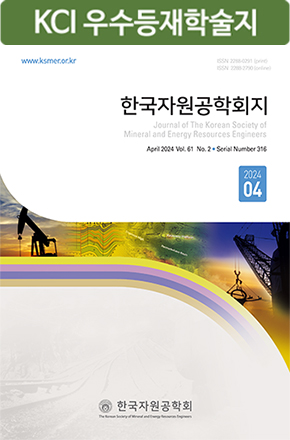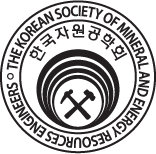Abstract
The potential risk and remediation priority of Hyungje, Suyeo, Myungbong, Dongil, Okdong and previously studied Au-Ag mines was investigated in order to compare the contamination of As and heavy metals around the Au-Ag mines. From the sequential extraction analysis, As and heavy metals existed mainly as both easily leachable and residual fraction. The variation of As concentration for the particle size showed the accumulation of As on smaller and larger particles due to weathering of tailings and mineral phases. From the pollution ratio for tailings and soils, it is necessary to consider the impact of As for estimating the potential risk of Au-Ag mining areas. Remediation priority of mine tailings is highest in the Dongil mine following the order of Okdong and Myungbong mine in terms of danger index. Myungbong mine tailing is naturally attenuated through the adsorption of As and heavy metals by hydrous ferric oxide, whereas Dongil mine tailing has the high potential of leaching and then should be remediated. Therefore, it is essential that dispersion of contaminants and their chemical species should be understood for evaluating the potential the remediation priority.
국내 금은 광산 주변 As 및 중금속의 오염 특성 비교를 위해서 형제, 수어, 명봉, 동일, 옥동 광산들을 기존 연구의 금은 광산들과 함께 오염 가능성과 복원순위에 대해 살펴보았다. 광미의 연속추출분석결과 As 및 중금속은 주로 유출 가능한 형태와 불용성 잔류형태로 존재하고, 입자 크기에 따른 As 부화정도는 풍화 과정과 존재 광물상에 따른 작은 입자와 큰 입자로의 축적 경향을 보여준다. 특히, 광미와 토양들의 오염지수에서 As가 오염에 기여 정도가 매우 높으므로, 금은 광산의 위해성 평가를 위해서 As의 오염을 고려해야한다. 위험지수를 이용한 오염원의 복원순위는 동일, 옥동, 명봉광산의 순서였다. 명봉광산 광미는 철산화물에 의한 As의 자연 저감효과가 높은 반면, 동일광산 광미의 As 및 중금속의 유출가능성이 높기 때문에 동일광산은 광미장의 복원이 긴요하다. 그러므로, 금은 광산일대의 오염 가능성과 복원순서를 적절히 평가하기 위해서는 As 유출에 따른 오염 분포와 그 화학종을 고려해야한다.
References
Sorry, not available.
Click the PDF button.
Information
- Publisher :The Korean Society of Mineral and Energy Resources Engineers
- Publisher(Ko) :한국자원공학회
- Journal Title :Journal of the Korean Society for Geosystem Engineering
- Journal Title(Ko) :한국지구시스템공학회지
- Volume : 40
- No :5
- Pages :367-378



 Journal of the Korean Society of Mineral and Energy Resources Engineers
Journal of the Korean Society of Mineral and Energy Resources Engineers








